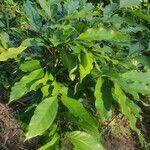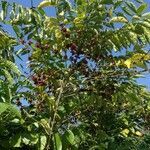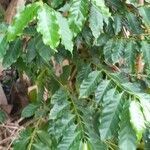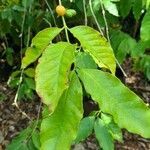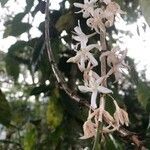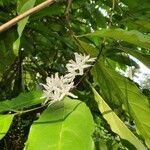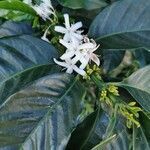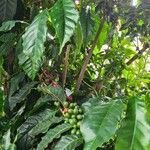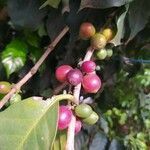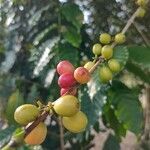Small trees or large shrubs, 5-8 m tall; branches flattened to subterete, glabrous. Petiole 8-15 mm, glabrous; leaf blade drying thinly leathery, elliptic, elliptic-oblong, or occasionally ovate-lanceolate, (2-)6-14(-22) × 3.5-5(-8.5) cm, glabrous on both surfaces, base cuneate to obtuse or rarely rounded, margins occasionally crisped-undulate, apex acuminate with tip usually 10-15 mm; secondary veins 7-10(-13) pairs, without domatia or with glabrous foveolate domatia; stipules broadly triangular, 3-8(-12) mm, aristate at least on youngest branches. Inflorescences with 1 to several cymes in each axil, each cyme subcapitate to fasciculate, (1 or)2-5-flowered, sessile to pedunculate with peduncles to 4 mm; bracts cupuliform, 1-2 mm; pedicels to 2 mm. Calyx glabrous; ovary portion ellipsoid, 1-3 mm; limb truncate to undulate or denticulate, 0.2-1 mm. Corolla white, funnelform, outside glabrous; tube 5-15 mm; lobes (4 or)5(or 6), spatulate-elliptic, 9-20 mm, obtuse. Drupe red, ellipsoid to subglobose, 11-16 × 9-14 mm, when dry smooth or sometimes weakly didymous, glabrous. Fl. Mar-Jul, fr. Oct-Jan.
Shrubs or trees, to 20 m tall, the branchlets straight or flexuous, glabrous, scarcely or moderately swollen at the nodes, the latter well spaced. Leaves el-liptic oblong, 8-18 cm long, 2.5-7.5 cm wide, distinctly acuminate at the apex, the acumen to 1.5 cm long, often falcate or somewhat hooklike, usually ultimately obtuse, attenuate or widely cuneate at the base, the costa prominulous above, subprominent beneath, the lateral veins 9-11, uniting to form a submarginal un-dulate vein to 0.8 cm from the margin, thin coriaceous to stiffly papyraceous, usually drying green or grey green; petioles to 1.2 cm long; stipules linear lan-ceolate, to 1.2 cm long, acute. Flowers not seen. Fruits plump, oblong. rotund, to 1.5 cm long, to 1 cm wide, rounded at the apex and the base, drying black brown or dull olive, glabrous, the calycine scar scarcely elevated, ringlike, to 2 mm in diam.
An evergreen shrub. It grows to 3-5 m high and spreads to 3 m across. The stem is slender and the branches are flexible. The leaves are glossy green, oblong, and tapering towards the tip. They occur opposite each other and have easy to see veins. The leaves are 10-15 cm long by 5 cm wide. The flowering stalks grow from these side branches and have 1-4 flowers. The flowers are white, with 5 petals. They have a scent. Flowers occur in clusters in the axils of leaves. The fruit are green but change to red when ripe. They contain 2 seeds. The seeds are grey-green. They are about 12 mm long. They are flattened on the side where they are pressed together. Coffee seeds are commonly called "beans".
